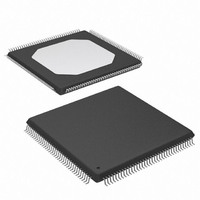XCV50-6TQ144C Xilinx Inc, XCV50-6TQ144C Datasheet - Page 15

XCV50-6TQ144C
Manufacturer Part Number
XCV50-6TQ144C
Description
IC FPGA 2.5V C-TEMP 144-TQFP
Manufacturer
Xilinx Inc
Series
Virtex™r
Datasheet
1.XCV100-5PQ240C.pdf
(76 pages)
Specifications of XCV50-6TQ144C
Number Of Logic Elements/cells
1728
Number Of Labs/clbs
384
Total Ram Bits
32768
Number Of I /o
98
Number Of Gates
57906
Voltage - Supply
2.375 V ~ 2.625 V
Mounting Type
Surface Mount
Operating Temperature
0°C ~ 85°C
Package / Case
144-LQFP
Case
TQFP144
Dc
03+
Lead Free Status / RoHS Status
Contains lead / RoHS non-compliant
Available stocks
Company
Part Number
Manufacturer
Quantity
Price
Company:
Part Number:
XCV50-6TQ144C
Manufacturer:
XIL
Quantity:
1 238
Company:
Part Number:
XCV50-6TQ144C
Manufacturer:
XILINX
Quantity:
988
with a common user interface regardless of their choice of
entry and verification tools. The XDM software simplifies the
selection of implementation options with pull-down menus
and on-line help.
Application programs ranging from schematic capture to
Placement and Routing (PAR) can be accessed through the
XDM software. The program command sequence is gener-
ated prior to execution, and stored for documentation.
Several advanced software features facilitate Virtex design.
RPMs, for example, are schematic-based macros with rela-
tive location constraints to guide their placement. They help
ensure optimal implementation of common functions.
For HDL design entry, the Xilinx FPGA Foundation develop-
ment system provides interfaces to the following synthesis
design environments.
•
•
•
For schematic design entry, the Xilinx FPGA Foundation
and alliance development system provides interfaces to the
following schematic-capture design environments.
•
•
Third-party vendors support many other environments.
A standard interface-file specification, Electronic Design
Interchange Format (EDIF), simplifies file transfers into and
out of the development system.
Virtex FPGAs supported by a unified library of standard
functions. This library contains over 400 primitives and mac-
ros, ranging from 2-input AND gates to 16-bit accumulators,
and includes arithmetic functions, comparators, counters,
data registers, decoders, encoders, I/O functions, latches,
Boolean functions, multiplexers, shift registers, and barrel
shifters.
The “soft macro” portion of the library contains detailed
descriptions of common logic functions, but does not con-
tain any partitioning or placement information. The perfor-
mance of these macros depends, therefore, on the
partitioning and placement obtained during implementation.
RPMs, on the other hand, do contain predetermined parti-
tioning and placement information that permits optimal
implementation of these functions. Users can create their
own library of soft macros or RPMs based on the macros
and primitives in the standard library.
The design environment supports hierarchical design entry,
with high-level schematics that comprise major functional
blocks, while lower-level schematics define the logic in
these blocks. These hierarchical design elements are auto-
matically combined by the implementation tools. Different
design entry tools can be combined within a hierarchical
DS003-2 (v2.8.1) December 9, 2002
Product Specification
Synopsys (FPGA Compiler, FPGA Express)
Exemplar (Spectrum)
Synplicity (Synplify)
Mentor Graphics V8 (Design Architect, QuickSim II)
Viewlogic Systems (Viewdraw)
R
www.xilinx.com
1-800-255-7778
design, thus allowing the most convenient entry method to
be used for each portion of the design.
Design Implementation
The place-and-route tools (PAR) automatically provide the
implementation flow described in this section. The parti-
tioner takes the EDIF net list for the design and maps the
logic into the architectural resources of the FPGA (CLBs
and IOBs, for example). The placer then determines the
best locations for these blocks based on their interconnec-
tions and the desired performance. Finally, the router inter-
connects the blocks.
The PAR algorithms support fully automatic implementation
of most designs. For demanding applications, however, the
user can exercise various degrees of control over the pro-
cess. User partitioning, placement, and routing information
is optionally specified during the design-entry process. The
implementation of highly structured designs can benefit
greatly from basic floor planning.
The implementation software incorporates Timing Wizard
timing-driven placement and routing. Designers specify tim-
ing requirements along entire paths during design entry.
The timing path analysis routines in PAR then recognize
these user-specified requirements and accommodate them.
Timing requirements are entered on a schematic in a form
directly relating to the system requirements, such as the tar-
geted clock frequency, or the maximum allowable delay
between two registers. In this way, the overall performance
of the system along entire signal paths is automatically tai-
lored to user-generated specifications. Specific timing infor-
mation for individual nets is unnecessary.
Design Verification
In addition to conventional software simulation, FPGA users
can use in-circuit debugging techniques. Because Xilinx
devices are infinitely reprogrammable, designs can be veri-
fied in real time without the need for extensive sets of soft-
ware simulation vectors.
The development system supports both software simulation
and in-circuit debugging techniques. For simulation, the
system extracts the post-layout timing information from the
design database, and back-annotates this information into
the net list for use by the simulator. Alternatively, the user
can verify timing-critical portions of the design using the
TRACE
For in-circuit debugging, the development system includes
a download and readback cable. This cable connects the
FPGA in the target system to a PC or workstation. After
downloading the design into the FPGA, the designer can
single-step the logic, readback the contents of the flip-flops,
and so observe the internal logic state. Simple modifica-
tions can be downloaded into the system in a matter of min-
utes.
®
Virtex™ 2.5 V Field Programmable Gate Arrays
static timing analyzer.
Module 2 of 4
11
®














